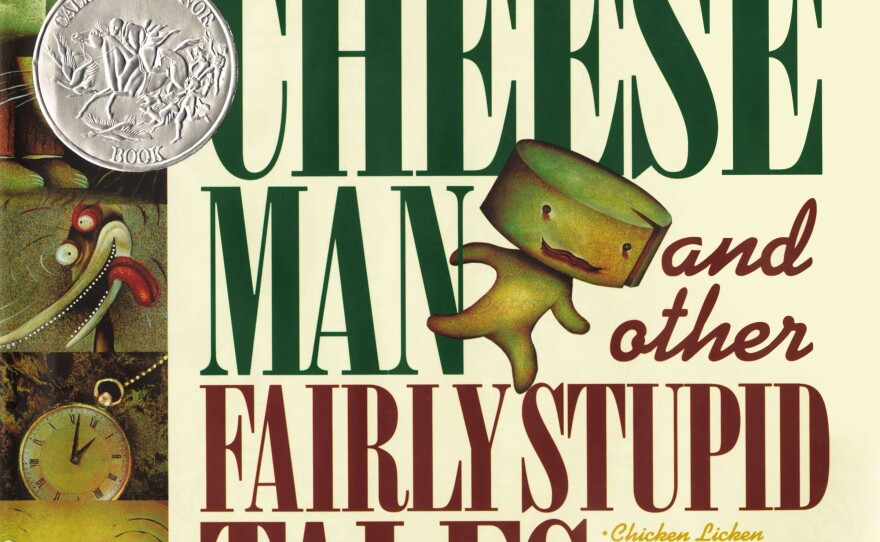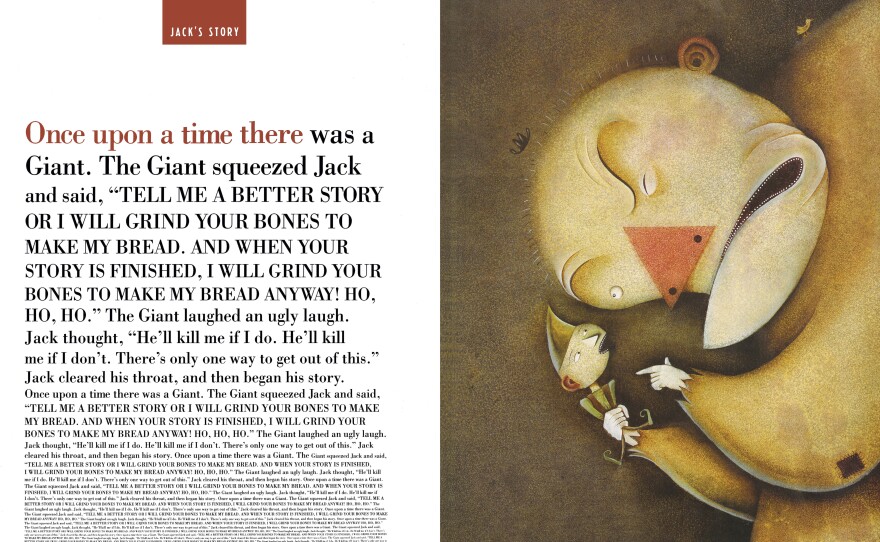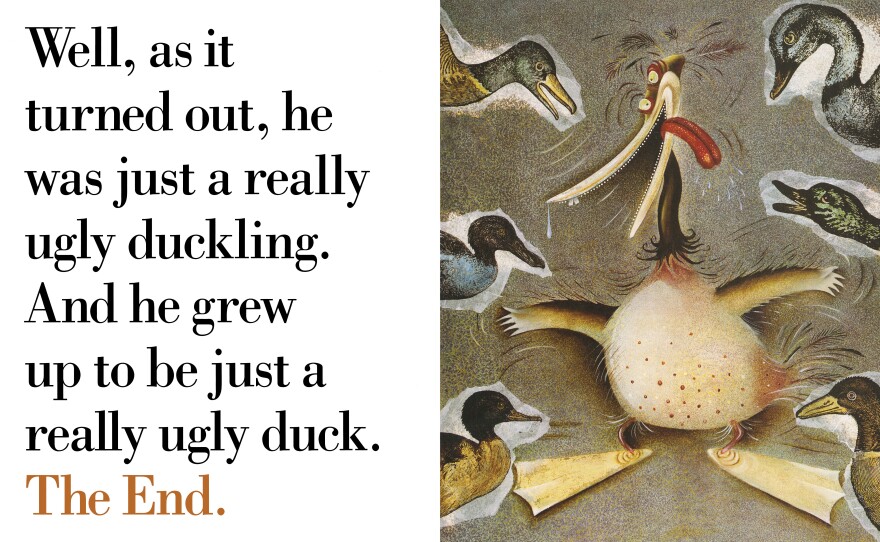Here's a story you might know — it's a classic fairy tale — "Once upon a time, there was a little old woman and a little old man who lived together in a little old house. They were lonely, so the little old lady decided to make a man out of stinky cheese."
It's Jon Scieszka and Lane Smith's take on The Gingerbread Man, with one very important plot twist — the stinky cheese man is so stinky that no one wants to run, run, run after him, much less eat him.
It's the title story of their 1992 children's book, The Stinky Cheese Man and Other Fairly Stupid Tales. Some of the other "fairly stupid tales" in the award-winning collection:
"The Really Ugly Duckling," "Little Red Running Shorts," and "Cinderumpelstiltskin."
Scieszka and Smith have worked together for decades and on more than a dozen books. They first met through their wives, who were working together at Sport magazine.
"I was off trying to sell children's books," says Scieszka. "Not having much luck." His wife, Jeri Hansen, said "Oh you should meet this guy who just did some art for the magazine."
The guy was Lane Smith, who'd gotten work at Sport from his then-girlfriend Molly Leach.
It was love at first sight — for Scieszka and Smith.
By that point, Scieszka had earned his master's degree in fiction writing, done some apartment painting ("Because that's about what you can do with an MFA."), gotten a lot of rejections for book manuscripts, and had turned to teaching elementary school, where he was exposed to some truly terrible leveled reading material for children.
"My second graders were going, 'Mr. Scieszka, why are we even reading this?' "
So he started testing out other material.
"Like, 'Hey, have you ever heard this story about a guy who woke up one morning and he was a bug?'"
The second graders were completely taken with Franz Kafka. He read them George and Martha, and Frog and Toad — anything other than the leveled readers.
When Scieszka and Smith met, they connected over a shared love of high culture, art and literature, but also pop culture.
"I was bringing all my favorite literary devices and books that I loved — metafiction — stuff like Tristram Shandy," says Scieszka. "He was bringing this wealth of experience from the art world, just bringing pure art. It seemed like such a good match."

Their first book together was The True Story of the Three Little Pigs — a take on the classic The Three Little Pigs, but narrated by the wolf. It was a hit.
For their second book, Scieszka decided to take a bunch of other fairy tales and completely deconstruct them.
"I thought ... it'll be a great investigation of what a book is," says Scieszka. "We can get rid of the narrator, we can get rid of plot, we can get rid of the action. I just made it my mission to mess with every element of storytelling."
Once they had the idea, they had to make it all make sense. They had a big bulletin board in Smith's studio. Scieszka would come over and they would storyboard together.
"We would just arrange stuff and rearrange stuff and say 'Well, how about if we started with this one.' And then we put this one at the end. And maybe this character could walk out of this story and go into this," says Smith. "It was one of those serendipitous things. One day we looked at the big board and it all worked."
The book's narrator is Jack — of Jack and the Beanstalk fame — but here he writes the introduction ("you should definitely go read the stories now, because the rest of this introduction just kind of goes on and on"). He interrupts Chicken Licken to tell the reader that he forgot to include the Table of Contents, which falls out of the sky.
Instead of an ugly duckling that grows up to be a swan, the ugly duckling in this book grows up to be a really ugly duck. Cinderella doesn't get to go to the ball, because instead of a Fairy Godmother she gets a visit from Rumpelstiltskin. A princess sleeps atop a bowling ball instead of a pea — because Jon Scieszka is a romantic.
Smith's wife, Molly Leach, helped them with a lot of the design elements of the book. The Table of Contents, after it falls out of the sky, is all crunched up on the page. Smith and Scieszka wanted to have all of the words run off one of the pages. Leach suggested instead, what if the words just got smaller, and smaller, and smaller?
"We were like, 'OK, yeah. That's way better,'" says Scieszka.

"It looks like it came out of magazines," says Smith. "It was like stuff I was doing for Rolling Stone." Smith did all the illustrations by hand, using a lot of collage elements.
In the story of the Really Ugly Duckling, for example, the duck is very cartoon-y and stylized, but surrounding him is clip art and old engravings of actual ducks and geese and mallards. It's a nice contrast, Smith says, to have something wacky next to something scholarly.
The constant in all his work, Smith says, is texture.
"I used thin coats of oil paint, and then I would spray them with a water-based varnish," says Smith. "And I would get out a hair dryer and blow it. And it would dry it instantly and the paint would beat up. But I would just build up layer and layer of oil ... move the paint around with my fingers."
"I think the short answer for Lane's technique is it's illegal now," says Scieszka.
"That's probably why I'm seeing a neurologist now," quips Smith.
Scieszka says people jokingly ask him all the time what he and Smith were smoking (paint fumes, it sounds like) when they made this book. Despite all the fun they had — including with the ping pong table in the studio — he says it really was a lot of work. And being in the room together was essential.
"It's the give and take of both arts telling the story," says Scieszka. "It's not just adding pictures on later."
What was really unique at the time the book came out, says Smith, is how sophisticated The Stinky Cheese Man is — and that it was a parody book for kids.
"Up until then, if there was parody, like if Tex Avery did parody in a cartoon, it was almost more aimed at the adults," says Smith. But The Stinky Cheese Man wasn't winking at the adults. "Every kid had read The Gingerbread Man, so when you say the stinky cheese man they get the joke."
And — it's really funny.
"These are stories that have been around for hundreds of years," says Scieszka. "And you just tweak them a little bit for this new audience and they can crack you up."
And Scieszka and Smith say that's the whole point — they never wanted to write a message book, just a funny one.
"Sometimes I'll get an email to my website where people say a book I've done has offended them in some way. And, 'Why did you write this?' " says Smith. "And I'll say, 'Well, I didn't write it for your kid!' You know, I just wrote it for like minded people who will find it funny."
"I think that's always been another common ground of like, we don't want to tell kids what to think," says Scieszka. "You read it. See what you think. See what comes out of it."
Copyright 2023 NPR. To see more, visit https://www.npr.org. 9(MDAzMjM2NDYzMDEyMzc1Njk5NjAxNzY3OQ001))








